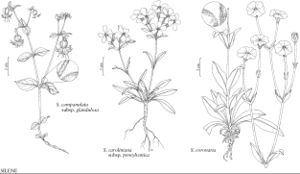Silene coronaria
Man. Herbor. Suisse, 145. 1811.
Plants perennial, grayish-white-tomentose, eglandular; taproot slender to stout; caudex branched, slightly woody. Stems several, erect, branched distally, stout, 40–100 cm. Leaves: basal blade oblanceolate, spatulate, 5–10 cm × 10–25 (–30) mm, margins entire, apex acute, apiculate, with tuft of white hairs; cauline in 5–10 pairs, sessile, reduced distally, blade with both surfaces obscured by dense, silky, grayish-white tomentum. Inflorescences with 1–several dichotomies, several-flowered, open, bracteate; branches ascending, elongate; bracts leaflike, 10–20 mm. Pedicels straight, stout, to 10 cm. Flowers ca. 35 mm; calyx thickly 10-veined, obovate, ca. 15 × 10 mm in fruit, margins dentate with 5 narrowly lanceolate lobes ca. 1/4 length of tube, tomentose; corolla rich magenta-pink, sometimes white, clawed, claw equaling calyx, limb spreading horizontally, broadly obovate, shallowly 2-lobed, appendages 2, narrow, 2–4 mm; stamens equaling claw; stigmas 5, equaling claw. Capsules equaling to tightly enclosed within calyx, obovate-elliptic, ca. 14 mm, opening by 5 spreading, lanceolate teeth; carpophore ca. 2 mm. Seeds grayish brown, reniform-rotund, plump, 1–1.5 mm, coarsely verrucate. 2n = 24.
Phenology: Flowering summer.
Habitat: Roadsides, fields, waste or rocky places
Elevation: 0-300 m
Distribution

Introduced; B.C., N.B., N.S., Ont., Que., Ala., Ark., Calif., Conn., Idaho, Ill., Ind., La., Md., Mass., Mich., Mo., N.H., N.J., N.Y., N.C., Ohio, Oreg., Pa., S.C., Utah, Vt., Va., Wash., W.Va., Wis., Europe
Discussion
Silene coronaria is commonly cultivated and occasionally escapes.
Selected References
None.
